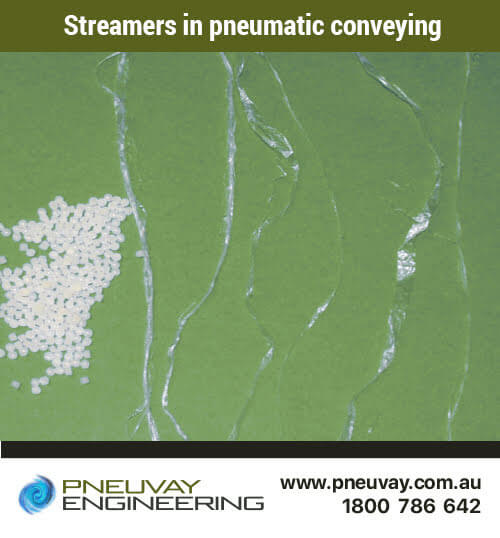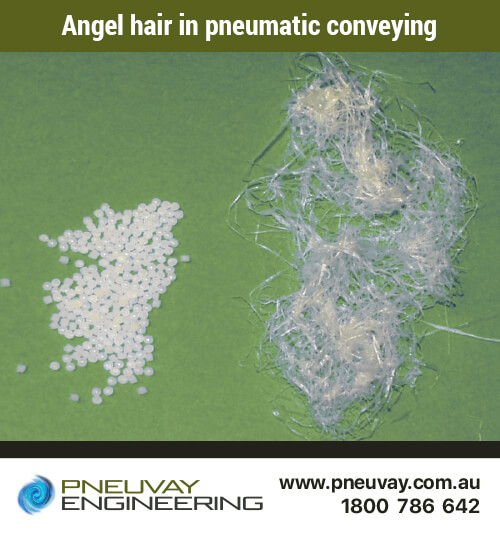See our latest projects and be updated with recent news and features
happening in the world of pneumatic conveying, materials handling
and industrial vacuum systems.
See our latest projects and be updated with recent news and features
happening in the world of pneumatic conveying, materials handling
and industrial vacuum systems.

Tuesday, April 30, 2019
Streamers and angel hair are indicative of a specific set of pellet pneumatic conveying system problems. They refer to types of ongoing and significant damage being made to a pellet-based product being pneumatically transported.


Streamers and angel hair generally result from a combination of specific factors. These include the pellet transfer speeds, pellet conveying system design, pellet and air temperatures and ratio of pellet-to-air.
Dilute (lean) phase pneumatic conveying is the common type of pneumatic conveying, and we will focus our discussion on this type of system. Dilute phase systems are typically low in pressure (13790 to 82737 Pa), have high transfer speeds (16 to 50 meters per second), with pellets-to-air ratios from 0.9 to 4.5 kgs/kg.
Pellets travelling at high speed melt from frictional heat when they slide along internal conveying surfaces. The liquefied part of the pellet then solidifies moments later when travelling along the internal wall and forms the streamers or angel hair.
Lowering the transfer speed is a way of reducing this problem. Setting the transfer speed below the saltation speed (minimum speed for pellets to stay airborne) will result in more pellets sliding along the inside conveying surfaces and most likely increasing the problem. The transfer speed that will produce the smallest amount of frictional heat is generally marginally above the saltation (minimum speed for pellets to stay airborne) speed, but this is not recommended.
From industrial experience, it has been determined that optimal transfer speed for dilute phase pneumatic conveying must be significantly greater than the saltation speed, but not greater than 28 meters per second.
Pellets experiencing frictional heat from excessive contact with internal conveying surfaces will occur at pipe bends and along vertically sloped piping. Pellet conveying system design needs to minimise the number of bends and slopes much as possible. Vertical piping minimises pellet contact with internal conveying surfaces, and should be maximised.
The longer the pneumatic conveying system, the higher the transfer speed of the pellets required to get the material through the system. To keep transfer speeds to ranges that do not cause streamers or angel hair, pneumatic conveying distances need to be designed to a minimum.
From industrial experience, pneumatic conveying systems that use long sweeping bends above ten diameters of radius will get an increase in pellet slide and result in streamers and angel hair. Below five diameters of radius, the formation of streamers and angel hair is much less; however, a system pressure drop increase may be unsatisfactory.
The temperature of pellets and conveying air being used to transport the pellets need to be minimised to reduce streamer and angel hair formation. Pneumatic conveying cooling equipment and making sure that correctly sized blowers are used can help control this factor.
From industrial experience, pellets and conveying air should be kept in an optimal range of 32 to 38 degrees and not exceed 55 degrees Celsius to reduce streamer and angel hair formation.
Pellet transfer speed may be reduced by increasing the ratio of pellets to air (kgs to kg). This can be achieved without adjusting blower output. All that is required is to increase the air locks dump transfer rates. As the conveying air needs to transport more pellets, the average pellet speed will decrease. This will result in pellets having, on average, less contact with the internal conveying wall surfaces, thus reducing streamers and angel hair.
However, the ratio increase ratio will increase product slide along internal conveying surfaces, as more pellets will be moving at less than the saltation speed. The increase in system pressure will require greater output from the blower, which may already be operating near or at maximum capacity.
From industrial experience, pellet-to-air ratios for dilute phase pneumatic conveying should be from 2.7 to 3.6 kgs/kg. Systems that operate above this range will become too sensitive to product and transfer rate changes.
Pneuvay is a leading pneumatic conveying system designer and can provide assistance in pellet pneumatic conveying system problems. To prevent angel hair and streamer formation, we examine transfer velocities and gas temperatures. We can reduce angel hair that may form by utilising separators. We service many large producers and provide best fit and turnkey solutions for processing plants looking to:
If you have any questions in relation to pneumatic conveying systems or need help with pellet pneumatic conveying system problems, feel free to call on 1300721458 or contact us. You can even send us a message via our Facebook page if you like.
Get social with us and see the latest news items from:
We recently made an exciting visit to Vortex in the USA to enhance our capabilities as a regional agent for their products.
Discover the valuable insights we gained and why we are proud to partner with Vortex!
Pipe and Tube Compression Couplings
Industrial Dust Collectors Systems
Dust Collectors Filters, Cartridges and Bags
Pneuvay Engineering Pty Ltd - Copyright 2020
ABN 49 006 027 541
